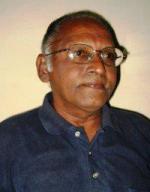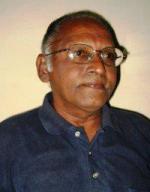.
.

Reshmi Pillai (Source: mathrubhumi.com)
Reshmi was the youngest of the three daughters of LIC agent Parameshwaran Pillai and Saradamaniamma from Kollam. About 13 years ago, Reshmi, a B.Ed. student was staying at Biju Radhakrishnan’s house as a paying guest.
Biju Radhakrishnan, a hardcore criminal, loved money and women and wanted to become a billionaire. Biju, believing that he could become rich by marrying Reshmi, enticed her, and Reshmi succumbed to his charming ways.
In 2001, they eloped, but did not get legally married. Their relation soured when Reshmi realized Biju’s follies and Biju came to know that she was not as wealthy as he had believed. However, after some period she returned and started living with Biju.

Saritha S. Nair (Source: newindianexpress.com)
Saritha S. Nair was born into a lower-middle-class family in Chengannur. At the age of 18, she married a Dubai-based NRI. After obtaining her B.Com degree, Saritha got a job at a private bank in Kozhencherry, where she cheated her employer of र2 lakh. Next, she joined a private firm where she came in contact with the already married Biju Radhakrishnan. They were intimate.
Reshmi opposed Biju’s relationship with Saritha. Very often Biju beat Reshmi and sometimes in front of their son. Not able to bear the blows, Reshmi left him and lived with her parents.
On February 4, 2006, Reshmi was found lying unconscious in the bathroom at Biju’s Kottarakkara house. She had head injuries. Biju assisted by his neighbours took her to a hospital. Biju claimed that she had hurt herself after slipping in the bathroom. Reshmi was declared dead on arrival. Relatives and neighbors were doubtful and did not believe that Reshmi committed suicide as she had two children to take care of.
Biju absconded after Reshmi’s death, and the Kottarakkara police registered five fraud cases against him. For the past seven years, the police and the crime branch were clueless about his whereabouts. Though he had committed huge frauds using fake names and addresses, not a single police person had seen him until the date of his arrest on June 17, 2013.
In 2007, after divorcing her husband, Saritha Nair lived with Biju Radhakrishnan.
The duo started their career in crime first by enticing people by providing loans at very low-interest rates. Next, they targeted businessmen needing large sums of money. Saritha would bait them by promising funds from abroad. Following the modus operandi of email scammers, Saritha would convince the victims that the loan would be sanctioned only after paying a service fee. After collecting around two to three lakh rupees, the duo would fade away.
In 2009, the police arrested the couple for cheating a resident of Kakkanad of र1.6 lakh after promising to install a windmill plant.
The duo began their career in crime first by enticing people by providing loans at very low-interest rates. Next, they targeted businessmen needing large sums of money. Saritha would bait them by promising funds from abroad. Following the modus operandi of email scammers, Saritha would convince the victims that the loan would be sanctioned only after paying a service fee. After collecting around two to three lakh rupees, the duo would fade away.
In 2009, the police arrested the couple for cheating a resident of Kakkanad of र1.6 lakh after promising to install a windmill plant.
In 2011, after their release, the couple moved their operation to Kochi, and launched Team Solar Renewable Energy Solutions aka The Team Solar Energy Company (Team Solar). They advertised Team Solar as “one of the world’s largest renewable energy groups.”
Needing political clout to exploit gullible people, Saritha cultivated contacts with the personal staff of politicians, including the personal aides of Kerala chief ministers. K C Joseph, present Minister for Rural Development, Planning&Culture of the Government of Kerala, inaugurated Saritha’s Kottayam office.
Starlets, sex, blackmail and murder formed the base of the duo’s Solar scam.
Shalu Menon

Shalu Menon
Shalu Menon, 30, a dancer-turned-television Malayalam actress, the granddaughter of a famous Kerala dancer, was the first actress involved in the Solar scam. Shalu’s role in the scam surfaced after an NRI businessman named Razik Ali filed a complaint that Biju Radhkarishnan and Shalu Menon had cheated him of र70 lakh by offering a non-existent franchise and a wind farm in Tamil Nadu.
Shalu Menon, Born into a middle-class family, was a familiar face in the cultural world of Kerala. She runs a chain of dance schools under the banner the Jayakerala School of Performing Arts, that boasts having more than 1,000 students. Acting in Malayalam films and TV serials since 1998, her social circle revolved around the rich, famous and powerful. Her political connections helped her earn a berth in the Kerala Censor Board.

Shalu Menon was arrested on July 5, 2013, as the third accused in the Solar scam. (Source: newindianexpress.com)
She was arrested on July 5, 2013, as the third accused in the Solar scam, and for committing an offence under IPC 212 for harbouring and helping the key
accused Biju Radhkarishnan to flee from the state of Kerala by giving him her car and mobile to use while escaping.
During interrogation by the police, Shalu Menon admitted to the links she had with Saritha Nair and Biju Radhkarishnan, the brains behind the scam. She told the police that Biju Radhkarishnan approached her requesting her to model for his company’s advertisements. Later, she became intimate with him.
Shalu Menon added that Saritha Nair too had approached her to learn dance at her school.
Biju had presented Shalu diamond, gold and silver ornaments, and had conveyed his intentions of marrying her. He had given her money to build a palatial house in Changanasserry, and she had helped Biju by enticing investors and politicians. Many politicians and VVIPs including Union minister Kodikkunnil Suresh and state Home Minister Thiruvanchoor Radhakrishnan were embarrassed when videos and photographs littered the media showing them attending the house-warming ceremony of Shalu’s palatial bungalow and enjoying the tender coconuts.
On investigation it was revealed that Shalu was a frequent visitor to Biju’s office in Thiruvananthapuram. The police found documents, including cheques and vouchers signed by Shalu in the office. Biju’s employees told the police that Biju introduced Shalu as an executive director of the firm.
Swiss Solar employee Likhitha filed a case against Shalu Menon and Biju Radhakrishnan for duping her of lakhs of rupees. In February 2013 Biju introduced Shalu as the Executive Director of Swiss Solar Company and promised to appoint Likhitha as the CEO of the company. He offered her a salary of rupees one lakh. But the actual salary that Likhitha received was only र50,000 while Biju swindled her to the tune of र1.19 lakhs on the pretext of office expenses. Actually, Biju used this money to clear the dues of his clients.
The affidavit filed by the Special Investigation Team (SIT) at the court said that Shalu Menon is the third accused in the case, and an offence under IPC 212 for harbouring an accused has been charged against her.
Uthara Unni

Uthara Unni (Source: balconybeats.com)
In July 2013, the name of another Mollywood film actress, Uthara Unni, surfaced in connection with the Solar Scam. Speaking to a Kerala TV channel, actress Urmila Unni, mother of Uthara, denied reports that her daughter was Team Solar’s brand ambassador, but only had modeled for Team Solar’s advertisements. However, a Facebook page in the name of Uthara Unni had mentioned her as the brand ambassador of Team Solar.
The Ernakulam South Police registered a FIR against Saritha Nair and Biju Radhakrishnan following the complaint by a Kochi-based travel agency with regard to a bounced cheque for र1.73 lakh given by the scammers after booking air tickets to Chennai and New Delhi. Uthara Unni was one of the passengers for whom the air tickets were booked.
According to the Special Investigation Team (SIT) that carried out by the Investigation said the budding actress is not directly involved in the case. “She travelled with Biju Radhakrishnan and Saritha Nair to Chennai only for advertisement photo shoots and is not directly linked with the scam.”
Urmila Unni admitted that her daughter Uthara went to Chennai, where she is studying, on the ticket provided by Team Solar.
The police then wanted to question Uthara about her travel details to Dubai with Biju Radhakrishnan.
Muktha Bhanu

Muktha Elsa George
In mid July 2013, Mollywood actress Muktha Elsa George, popularly known as Muktha or Bhanu, said that she was cheated by Biju Radhakrishnan of Team Solar. According to her, Biju had approached her and promised to include her in the calendar photo shoot for Team Solar, as a replacement for Uthara Unni, who did not curry favour with his associates. She accepted rupees ten thousand as an advance from Biju Radhakrishnan for this assignment. She also said that Biju had offered a job for her sister in the solar office in Thiruvannathapuram, but was double crossed.
Solar Swapnam, The Movie
The notorious Solar scam scandal that stirred the political stability of Kerala has swayed the Malayalam film industry too. Now, an American Film Company named Dream World Productions has launched production of a movie titled “Solar Swapnam” directed by joy Antony and scripted by Raju George. K. Jayakumar has penned the lyrics for the film and Jayan Ezhuman Thuruthu has composed the music.

Actress Pooja will characterize Saritha S. Nair and bear the name Haritha S. Nair (Source: entertainment.oneindia.in)
It is hoped that the movie Solar Swapnam would narrate the whole solar scam. Kollywood actress Pooja will characterize Saritha S. Nair and bear the name Haritha S. Nair. Kollywood actor Bhuvan will portray Biju Radhakrishnan. Kollywood actors Jananardhanan, Harisree Asokan, Nandhu, Mohan Roy, Sona Nair, P. Sreekumar and Aarthi Puri will act in significant roles in the movie.
.
← PREVIOUS: PART 2 – The Arrests TO BE CONTINUED …
.
RELATED ARTICLES
- “Callgate” / “Kerala Solar Scam”: Part 1 – Team Solar (tvaraj.com)
- “Callgate” / “Kerala Solar Scam”: Part 2 – The Arrests (tvaraj.com)
- 25 plaints against duo (deccanchronicle.com/)
- Shock To The System (tehelka.com)
- Office employee files suit against Shalu Menon and Biju (newskerala.com)
- Actresses and femme fatales in Kerala solar stew of scandal (newindianexpress.com)
- Name of actress Uttara Unni crops up in solar scam (newindianexpress.com)
- Another actor linked to Team Solar (thehindu.com)
- Pooja To Enact Saritha S Nair Onscreen! (entertainment.oneindia.in)
.









 THIS IS MY BELOVED INDIA!
THIS IS MY BELOVED INDIA!





















































































































































